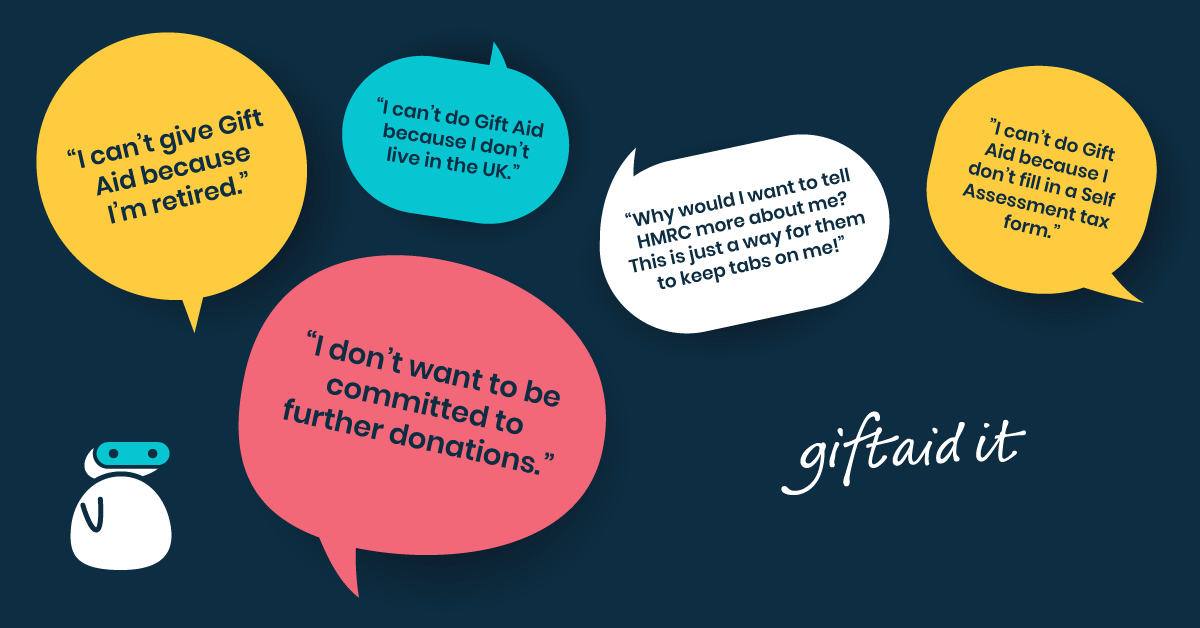Involving multiple forms, numerous cards and baffling entries on tax self-assessment forms — it is no surprise that the intricacies of how Gift Aid works can appear something of an arcane science.
Swiftaid is defeating the myths about Gift Aid and explaining what it’s all about:
Recent developments around GDPR and high-profile hacks resulting in loss of privacy have only contributed to a general wariness about passing out too much information on yourself and your finances.
The simple truth of the matter is Gift Aid is a form of tax relief that allows charities to claim additional funds (running into the millions) — without costing a penny to the donors that support their causes.
Even relatively short conversations about Gift Aid reveal the extent of the confusion out there, and a quick glance at various Internet forums show plain misinformation masquerading as fact.
Let’s take a look at some of the more common opinions, facts and statements made about Gift Aid.
“It’s just not worth the trouble for small donations.”
We completely understand that when you’re simply dropping some paperbacks off at your favourite charity shop, it can be frustrating to be asked to fill in another Gift Aid declaration form. It is highly likely that the poor volunteer who has to ask is equally reluctant to request another favour. The thing is, they, like us, know that even tiny amounts add up, and when you consider an astonishing £564 million in Gift Aid is lost by charities each year, it adds up to a significant amount.
“Why would I want to tell HMRC more about me? This is just a way for them to keep tabs on me!”
While daunting on the surface, the Gift Aid Declaration form merely confirms that you are a UK taxpayer along with your name and address (information HMRC will certainly have if you are a UK taxpayer). So unless you don’t pay tax (in which case you are not eligible for Gift Aid anyway) HMRC already knows everything on the Gift Aid Declaration Form and plenty more besides!
“I can’t give Gift Aid because I’m retired.”
Even if they have technically stopped work, some pensioners continue to pay tax (for instance on investments or property) and are therefore eligible for Gift Aid if they donate to UK charities.
“I’m frightened of receiving a tax bill for Gift Aid.”
Provided you ensure you never claim more Gift Aid than the amount of tax you pay, this will not happen.
“I don’t want to be committed to further donations.”
Gift Aid entirely relates to donations you have already made. This allows a charity to claim back the tax you have paid on the donation — thus boosting the income they get by 25% without costing you a penny more.
The Gift Aid Declaration Form in no way entitles charities to take, or even to ask you for additional donations.
”I can’t do Gift Aid because I don’t fill in a Self Assessment tax form.”
Even if you pay tax through other methods, such as PAYE, provided you do pay tax, you can still add Gift Aid to your donations.
If you are a higher rate taxpayer, there is an advantage to filling in a self-assessment form, because this is how you can reclaim tax relief on your gross donations at 20%.
“I can’t do Gift Aid because I don’t live in the UK.’
Provided you still pay tax over here (potentially due to British property investments) you are still able to add Gift Aid to any donations you make. You simply need to ensure that the amount you add in Gift Aid does not exceed the amount of UK tax that you pay.
“I can add Gift Aid on behalf of a company.”
Actually no. As Gift Aid is a tax relief it is entirely tied to individual tax accounts and therefore you may only make Gift Aid declarations on your own taxpayer status. However, if a company is donating directly to the charity they may claim tax relief on the donation.
“I have claimed Gift Aid on tickets I have purchased for a charity event.”
Not quite right either. Gift Aid is only eligible on donations, and when items or services are received in return for money — this is classed as a purchase instead.
“It costs me to Gift Aid.”
When entering certain attractions such as zoos or museums you may have noticed there may be a ‘normal’ price and a (higher) Gift Aid price. No one (taxpayer or otherwise) is obligated to pay the Gift Aid price, and you can request this to be removed if it has been added automatically. The reason this sometimes happens is that the Gift Aid price includes an additional (voluntary) donation, which then allows the charity to claim Gift Aid on the full cost — as if this was entirely a donation.
A detailed look into the subject would undoubtedly reveal even more misunderstandings, and we know from previous studies, such as that by the Charity Tax Commission, that much work is being done on defeating the myths about Gift Aid.
Ultimately though, Gift Aid is a valuable source of income available to charities, and Swiftaid passionately believes that this should not only be restricted to charities with the necessary resources to manage the associated admin.
We are committed to delivering a product that enables all charities to claim their full Gift Aid entitlement, automating the process and bypassing administrative, auditing and GDPR requirements. Donors too can say goodbye to lengthy and repetitive Gift Aid declaration forms, simply knowing the excellent causes they choose to support are benefiting from the maximum donation — without them having to do, or pay a thing more.



